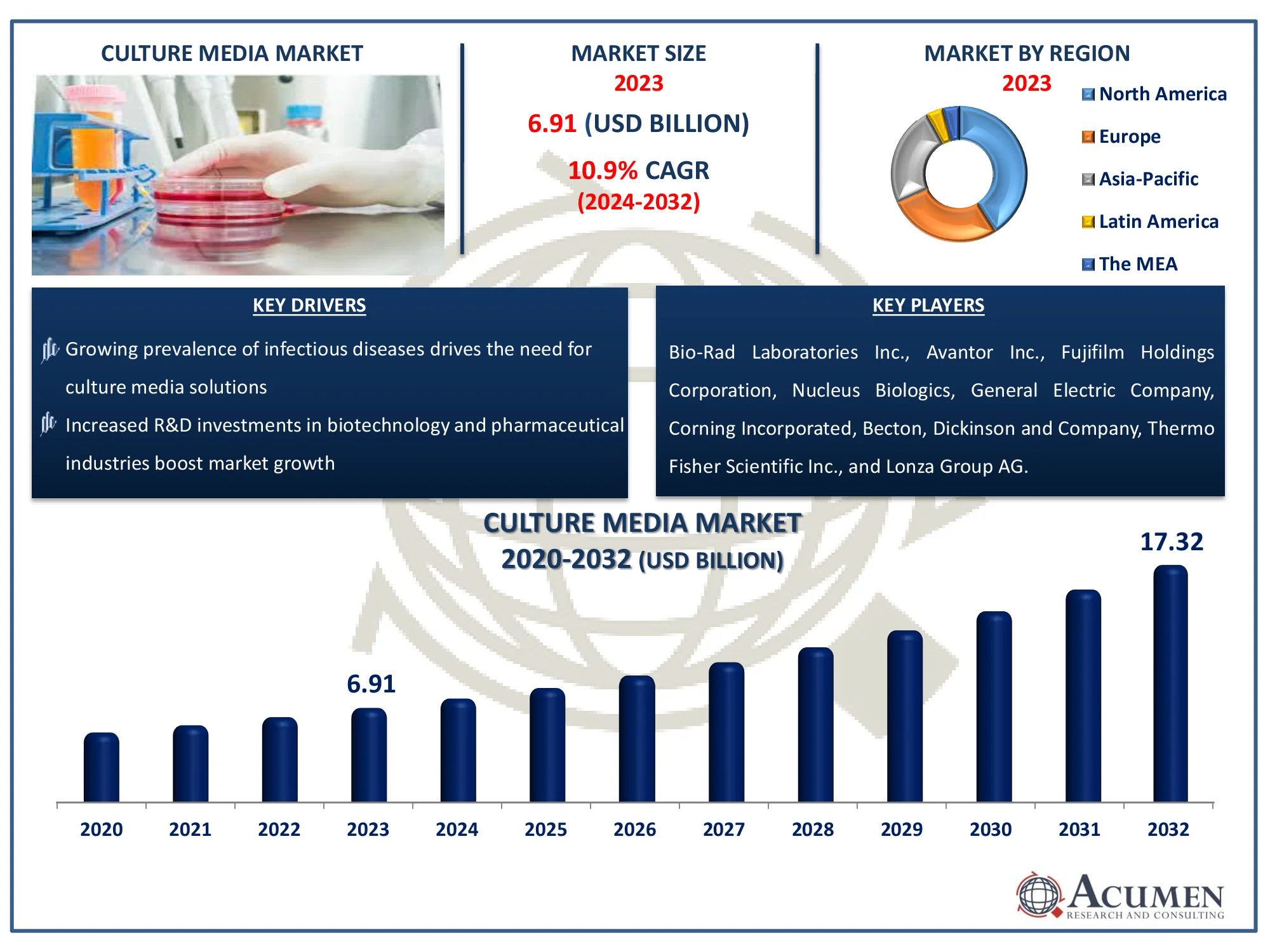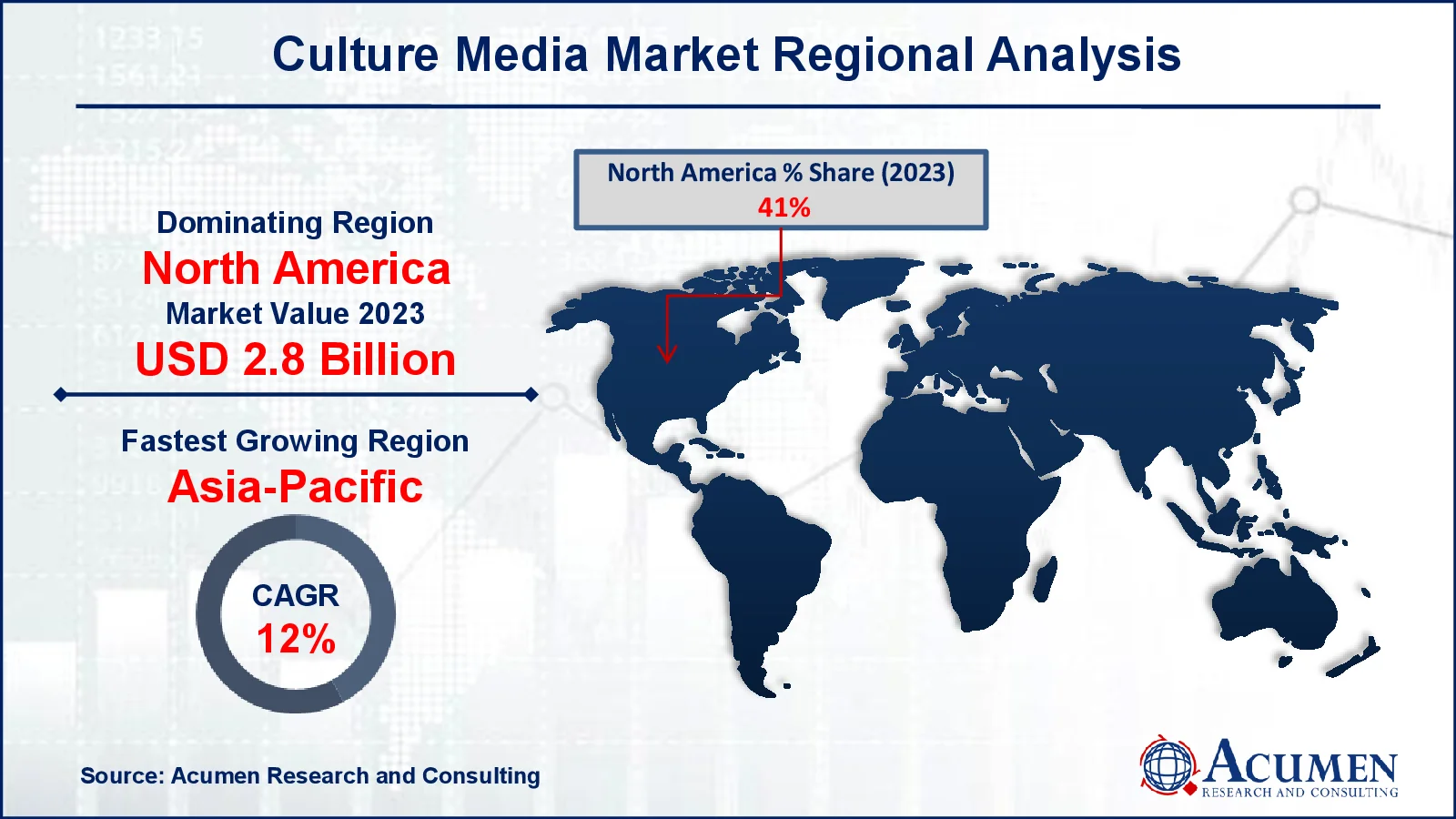Culture Media Market Size (By Type, By Research Type, By Application, By End-User, and By Geography) - Global Industry, Share, Analysis, Trends and Forecast 2024 - 2032
Published :
Report ID:
Pages :
Format :
Culture Media Market Size (By Type, By Research Type, By Application, By End-User, and By Geography) - Global Industry, Share, Analysis, Trends and Forecast 2024 - 2032
Report Coverage
- Industry Dynamics
- Market Size and Forecast Data
- Segment Analysis
- Competitive Landscape
- Regional Analysis with a Niche Focus on Country-Level Data
- High Level Analysis - Porter's, PESTEL, Value Chain, etc.
- Company Profiles of Key Players
- Option to Customize the Report As Per Your Specific Need
Request Sample Report
The Global Culture Media Market Size accounted for USD 6.91 Billion in 2023 and is estimated to achieve a market size of USD 17.32 Billion by 2032 growing at a CAGR of 10.9% from 2024 to 2032.
Culture Media Market Highlights
- Global culture media market revenue is poised to garner USD 17.32 billion by 2032 with a CAGR of 10.9% from 2024 to 2032
- North America culture media market value occupied around USD 2.8 billion in 2023
- Asia-Pacific culture media market growth will record a CAGR of more than 12% from 2024 to 2032
- Among research type, the cell therapy sub-segment generated notable revenue in 2023
- Based on application, the drug discovery sub-segment generated around 34% culture media market share in 2023
- Favorable government policies and increased funding is a popular culture media market trend that fuels the industry demand

Culture media consists of various nutritional contents that help in the growth, proliferation, preservation and storage of other cell types such as stem cells or other cell lines and microbial cells. In concern with the cell lines or microbial cells to regenerate and multiply in their incubation environments, different types of culture media are available in the market. Culture media is solid, semi-solid, or liquid mapped out to speed up the growth of population of microorganisms or cells through the process of cell amplification. Types of cell culture can support in the evolution of monoclonal antibodies. These antibodies can be produced with the help of cell culture media in the laboratories.
Global Culture Media Market Dynamics
Market Drivers
- Growing prevalence of infectious diseases drives the need for culture media solutions
- Increased R&D investments in biotechnology and pharmaceutical industries boost market growth
- Technological advancements in culture media enhance product efficiency and application
- Rising adoption of personalized medicine amplifies demand for advanced culture media
Market Restraints
- Stringent regulations and high drug approval costs hinder market expansion
- Lack of skilled professionals limits the widespread adoption of culture media
Market Opportunities
- Product innovation and strategic alliances among key players create growth prospects
- Expanding stem cell research unlocks new opportunities for culture media manufacturers
- Growth in 3D cell culture technology drives demand for advanced culture media products
Culture Media Market Report Coverage
|
Market |
Culture Media Market |
|
Culture Media Market Size 2023 |
USD 6.91 Billion |
|
Culture Media Market Forecast 2032 |
USD 17.32 Billion |
|
Culture Media Market CAGR During 2024 - 2032 |
10.9% |
|
Culture Media Market Analysis Period |
2020 - 2032 |
|
Culture Media Market Base Year |
2023 |
|
Culture Media Market Forecast Data |
2024 - 2032 |
|
Segments Covered |
By Type, By Research Type, By Application, By End-User, and By Geography |
|
Regional Scope |
North America, Europe, Asia Pacific, Latin America, and Middle East & Africa |
|
Key Companies Profiled |
Bio-Rad Laboratories Inc., Fujifilm Holdings Corporation, HiMedia Laboratories Pvt. Ltd., Nucleus Biologics, Avantor Inc., General Electric Company, Merck and Co. Inc., Corning Incorporated, Becton, Dickinson and Company, Thermo Fisher Scientific Inc., and Lonza Group AG. |
|
Report Coverage |
Market Trends, Drivers, Restraints, Competitive Analysis, Player Profiling, Covid-19 Analysis, Regulation Analysis |
Culture Media Market Insights
The rising frequency of infectious diseases is a major driver for the market, highlighting the need for effective diagnostic and therapeutic tools. For instance, The World Health Organization (WHO) has issued a new tuberculosis report, estimating that around 8.2 million people were newly diagnosed with the disease in 2023. This is the highest amount observed since WHO began worldwide TB monitoring in 1995, up from 7.5 million cases in 2022. Tuberculosis will once again be the greatest infectious disease killer in 2023, surpassing COVID-19.
Culture media are essential in isolating and identifying pathogens, allowing for proper illness diagnosis and therapy planning. The rise in global epidemics of respiratory and waterborne diseases has raised the need for high-quality culture media in clinical laboratories and research facilities. Furthermore, developments in microbial culture techniques, as well as a greater emphasis on disease surveillance and control, are driving the adoption of new culture medium solutions, improving the market's long-term growth prospects.
Ministry of Health and Family Welfare estimates that through initiatives such as the Universal Immunization Programme, Mission Indradhanush, and the U-WIN portal, the country has made significant progress in expanding immunization coverage, addressing vaccine-preventable diseases, and lowering child mortality. As a result of these efforts, the culture media market is seeing growth, driven by the rising demand for high-quality media in vaccine production and disease monitoring.
Furthermore, rise in finance support and investments in research and development and innovation in the life science sector helped to increase the growth of the market. The extension in market size is also depends upon the financial support for the cell based research, giving first choice for single based technologies and initiation of advanced cell culture products. Increase in the occurrence of infectious diseases like COVID-19 due to increased population and increased contact of humans has escalated the risk towards the infection. This rising threat of virulent disease and transmissible diseases offers potential growth opportunities for the key players in the culture media market. But, the shortage of trained professionals, principled and methodical concerns along with culture media can hamper the market growth.
Culture Media Market Segmentation
The worldwide market for culture media is split based on type, research type, application, end-user, and geography.
Culture Media Types
- Lysogeny Broth
- Stem Cell Media
- Chemical Defined Media
- Serum-Free Media
- Classical Media
- Custom Media Formulation
- Specialty Media
- Others
According to culture media industry analysis, by type, chemically defined media acquires the leading market share, after chemically defined media the lysogeny broth market is expected to lead the market, as it suggest consistency in each set and physiologically applicable surroundings for varied mammalian cell cultures. Another major reason to lead the market by lysogeny broth in the forecast period is because of massive approval and applications of this media for the escalation of quite a few microorganisms.
Culture Media Research Types
- Cell Therapy
- Cytogenetics
- Others
The cell therapy sector is expected to generate the greatest revenue in the culture media market forecast period due to its importance in fostering regenerative medicine and personalized healthcare. Specialized culture media are necessary for cell growth, differentiation, and maintenance throughout the development of cell-based therapies. The rising prevalence of chronic diseases, as well as increased demand for new treatments such as CAR-T cell therapy, have accelerated the expansion of this market. Furthermore, expanding investments in clinical research and development, combined with the expansion of biopharmaceutical manufacturing, have increased the demand for high-quality culture medium. These considerations place cell therapy as the largest revenue generator in the culture media market.
Culture Media Applications
- Biopharmaceuticals
- Cancer Research
- Regenerative Medicine & Tissue Engineering
- Drug Discovery
- Stem Cell Technologies
- Others
The drug discovery segment dominates the culture media market, owing to its crucial role in identifying and creating new medicinal molecules. Preclinical and high-throughput screening techniques require culture media to sustain cell lines and microorganism development. The rising prevalence of chronic and infectious diseases has increased demand for new medication development, putting more emphasis on high-performance culture media. Advances in biotechnology, such as 3D cell culture and organ-on-a-chip models, have demonstrated the importance of optimum medium compositions in shortening discovery time. Furthermore, growing global spending on pharmaceutical R&D increases the drug development segment's position in the cultural and media industries.
Culture Media End-Users
- Research Laboratory
- Academic Institute
- Biotechnology And Pharmaceuticals Sector
- Others
The biotechnology and pharmaceutical sector segment holds the largest market share and is expected to observe the leading market segment in the culture media market forecast period. The increase in single use technologies, the growing quantity of regulatory approvals for culture based vaccines. And the occurrences of the huge pharmaceutical players in the market are driving the culture media market for this segment.
Culture Media Market Regional Outlook
North America
- U.S.
- Canada
Europe
- U.K.
- GermanyS
- France
- Spain
- Rest of Europe
Asia-Pacific
- India
- Japan
- China
- Australia
- South Korea
- Rest of Asia-Pacific
Latin America
- Brazil
- Mexico
- Rest of LATAM
The Middle East & Africa
- South Africa
- GCC Countries
- Rest of the Middle East & Africa (ME&A)

Culture Media Market Regional Analysis
The culture media market varies greatly by geography, with North America leading because to its sophisticated biotechnology sector and major pharmaceutical R&D initiatives. The presence of large biopharmaceutical companies and research universities generates a demand for high-quality culture material. The region receives major government funding for life science, drug discovery, and regenerative medicine research. The United States, in particular, dominates this market due to its well-developed healthcare infrastructure and emphasis on tailored treatment.
The Asia-Pacific area is growing the fastest, owing to increased R&D efforts and the expansion of biopharmaceutical production in countries such as China, India, and South Korea. Growing healthcare spending, an increase in the prevalence of chronic diseases, and supportive government programs for biotechnology and pharmaceuticals all drive market growth. The region also benefits from cheaper operational expenses and a competent workforce, making it an appealing outsourcing destination.
Culture Media Market Players
Some of the top culture media companies offered in our report includes Bio-Rad Laboratories Inc., Fujifilm Holdings Corporation, HiMedia Laboratories Pvt. Ltd., Nucleus Biologics, Avantor Inc., General Electric Company, Merck and Co. Inc., Corning Incorporated, Becton, Dickinson and Company, Thermo Fisher Scientific Inc., and Lonza Group AG.
Frequently Asked Questions
How big is the culture media market?
The culture media market size was valued at USD 6.91 billion in 2023.
What is the CAGR of the global culture media market from 2024 to 2032?
The CAGR of culture media is 10.9% during the analysis period of 2024 to 2032.
Which are the key players in the culture media market?
The key players operating in the global market are including Bio-Rad Laboratories Inc., Fujifilm Holdings Corporation, HiMedia Laboratories Pvt. Ltd., Nucleus Biologics, Avantor Inc., General Electric Company, Merck and Co. Inc., Corning Incorporated, Becton, Dickinson and Company, Thermo Fisher Scientific Inc., and Lonza Group AG.
Which region dominated the global culture media market share?
North America held the dominating position in culture media industry during the analysis period of 2024 to 2032.
Which region registered fastest CAGR from 2024 to 2032?
Asia-Pacific region exhibited fastest growing CAGR for market of culture media during the analysis period of 2024 to 2032.
What are the current trends and dynamics in the global culture media industry?
The current trends and dynamics in the culture media industry include growing prevalence of infectious diseases drives the need for culture media solutions, and increased R&D investments in biotechnology and pharmaceutical industries boost market growth.
Which type held the maximum share in 2023?
The chemical defined media type the held notable share of the culture media industry.



